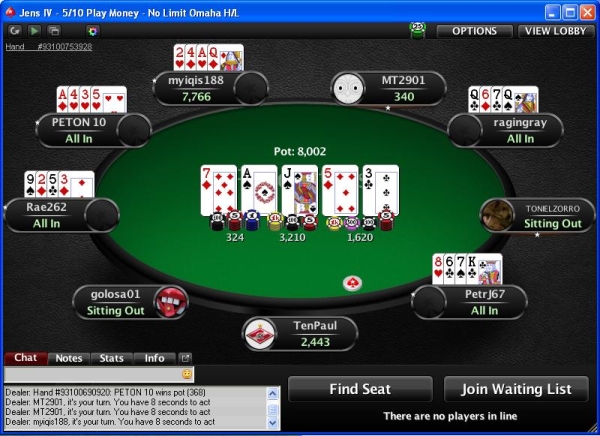Omaha Hi-lo is a special version of Omaha Hold’em, a game originally introduced by casino executive Robert Turner in the early 1980s. When Turner was managing the Horseshoe card room in Gardena, California in 1986, he introduced a mixed version of Omaha; one round would be the standard game, then the next would be a “split-pot” variant. Online Omaha Hi/Lo is a variant of Omaha in which the pot is split between the holder of the highest hand and the holder of the lowest hand if that low hand is topped by no worse than an 8. (The 8 is known in the poker world as a qualifier.) If that restriction is not met, the entire pot goes to the holder of the highest hand.
There’s an old saying “Never let the odds stop you from doing in your heart what you know you should do.”
Up to a point, I like this saying. Poker is all about heart: Players with courage and conviction, plus the ability to read their opponents, are often the most successful. But as a maths guy, I also think that it helps to have a good understanding of the stats. If nothing else, you need to know the odds which you are disregarding! This is especially true in the limit games, where you can’t blast your opponent off a hand with a big raise.
On this page I’m going to be adding various O8 odds and stats over the coming weeks. It’s quite a big project, so we’ll take it step by step. My main source is going to be the excellent site ProPokerTools. I also recommend Wikipedia’s Omaha Probability page. I will refer to other sources as appropriate.
A2 hands
A starting hand containing a bare A2 (with two high cards) can expect to make a low on the flop 7% of the time. This increases to 21% by the turn and 37% by the river. In other words, with a bare A2 you will make a low a little more than one third of the time when the hand is played out to the river.
Note also that when you make a low on the flop, you will be counterfeited (by another A or 2 falling on the turn or river) approximately one time in every four, in which case your hand could become worthless.
You can expect to have the nut low (whether on your own or shared) 25% of the time.

Omaha Hi-lo Strategy
A23 hands
A starting hand containing A23x (where x is a high card) can expect to make a low on the flop 12% of the time. This increases to 31% by the turn and 49% by the river. You can expect to have the nut low on the river 43% of the time.
The significant advantage that A23 has compared against A2 is the protection against being counterfeited. On a flop of 678, for example, the A23 should only expect to be counterfeited by runner runner cards 2% of the time. On a flop of 458, a counterfeit A, 2 or 3 will of course make you a very welcome wheel.
The strong counterfeit protection afforded by A23 along with the increased wheel potential shows why this is generally regarded as a ‘capping’ hand pre flop.
A single suited Ace

Omaha 8 is all about scooping, and nothing provides better scooping potential than a suited A2. So how often can we expect to make a flush with a suited Ace?
With a single suited Ace, you can expect to flop a flush just under 1% of the time. You will make a flush 3.3% of the time by the turn, and 7% by the river. For those who like playing your flush draws strongly (a particularly good idea when you also have a low draw), you should expect to flop four to a flush (e.g. one card needed to make a flush) 13% of the time.
Double suited Aces
With double suited Aces, the probability of making a flush by the river is (not surprisingly) twice that of the single suited ace. So you will flop a flush 2% of the time, make a flush on the turn 6.7 of the time, and make a flush on the river 14% of the time. If your hand also has decent low potential (with another wheel card) you should certainly be looking to cap the pot pre flop if you can.
Bare Aces
If you’ve read my book Winning at Hi Low Poker then you’ll know that I think bare Aces are the most over-rated hands in Omaha 8. Aces with wheel cards, or holding single or double suited Aces gives you more than one way to win a hand. However bare Aces such as AA78 or AA99 are asking for trouble. The problem is that unimproved Aces will find it difficult to hold up in a multi-way pot, and their scope to improve is limited. For example:
Omaha Hi-lo Rules
– There is only a 10% chance that AA78 will make a full house or better by the river.
– If the hand is unsuited, then there is only a 21% chance that it will make a straight or better by the river.

In a heads up pot this may be sufficient, but multi-way you will often find yourself second or even third best. For example, against two other opponents with random hands, AA78 unsuited holds only 44% equity. AA99 unsuited has a deeply unimpressive 35% equity against two other players with random cards.
Omaha Hi-lo Rules Pot
Moral of the story: If you hold bare Aces, then try to get the pot heads up if you can. Strongly consider discarding the weakest Aces, especially where the pot is multi-way or has already been raised and re-raised.
Omaha High Low Poker
Coming next
Omaha Hi Lo App
Next I’ll be covering marginal hands, including Kings and wheel cards e.g. 2-3-4-x. Any other requests, let me know.